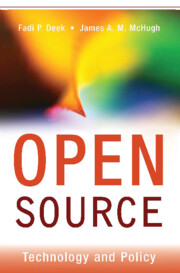Book contents
- Frontmatter
- Contents
- Preface
- Acknowledgments
- 1 Introduction
- Section One Open Source – Internet Applications, Platforms, and Technologies
- 2 Open Source Internet Application Projects
- 3 The Open Source Platform
- 4 Technologies Underlying Open Source Development
- Section Two Social, Psychological, Legal, and Economic Aspects of Open Source
- Section Three Free Software: The Movement, The Public Sector, and the Future
- Glossary
- Subject Index
- Author Index
- References
4 - Technologies Underlying Open Source Development
Published online by Cambridge University Press: 16 January 2010
- Frontmatter
- Contents
- Preface
- Acknowledgments
- 1 Introduction
- Section One Open Source – Internet Applications, Platforms, and Technologies
- 2 Open Source Internet Application Projects
- 3 The Open Source Platform
- 4 Technologies Underlying Open Source Development
- Section Two Social, Psychological, Legal, and Economic Aspects of Open Source
- Section Three Free Software: The Movement, The Public Sector, and the Future
- Glossary
- Subject Index
- Author Index
- References
Summary
The free software movement emerged in the early 1980s at a time when the ARPANET network with its several hundred hosts was well-established and moving toward becoming the Internet. The ARPANET already allowed exchanges like e-mail and FTP, technologies that significantly facilitated distributed collaboration, though the Internet was to amplify this ability immensely. The TCP/IP protocols that enabled the Internet became the ARPANET standard on January 1, 1983. As a point of reference, recall that the flagship open source GNU project was announced by Richard Stallman in early 1983. By the late 1980s the NSFNet backbone network merged with the ARPANET to form the emerging worldwide Internet. The exponential spread of the Internet catalyzed further proliferation of open source development. This chapter will describe some of the underlying enabling technologies of the open source paradigm, other than the Internet itself, with an emphasis on the centralized Concurrent Versions System (CVS) versioning system as well as the newer decentralized BitKeeper and Git systems that are used to manage the complexities of distributed open development. We also briefly discuss some of the well-known Web sites used to host and publicize open projects and some of the services they provide.
The specific communications technologies used in open source projects have historically tended to be relatively lean: e-mail, mailing lists, newsgroups, and later on Web sites, Internet Relay Chat, and forums. Most current activity takes place on e-mail mailing lists and Web sites (Feller and Fitzgerald, 2002).
- Type
- Chapter
- Information
- Open SourceTechnology and Policy, pp. 119 - 156Publisher: Cambridge University PressPrint publication year: 2007



